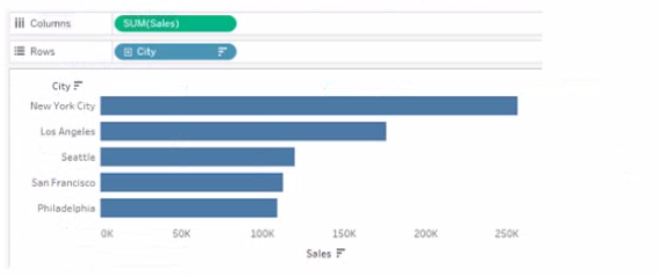Tableau TDA-C01 Tableau Certified Data Analyst Exam Practice Test
You have a data source that contains data tor every city in the Unites States. The following is a sample of the data.

You need to use the City dimension to create a dynamic filter that snows the cities that have a population greater than one million Which type of filter should you use?
Answer : D
To use the City dimension to create a dynamic filter that shows the cities that have a population greater than one million, you should use a condition filter. A condition filter is a type of filter that shows only the values that meet a specified condition based on a measure or a calculation. You can create a condition filter by dragging a dimension to the Filters shelf and selecting Condition from the dialog box. Then you can enter a formula or choose an option that defines your condition.
In this case, you want to create a condition filter based on Population, which is a measure. You can drag City to the Filters shelf and select Condition from the dialog box. Then you can choose By field from the tab and select Population > Sum > Greater than > 1000000 from the drop-down lists. This will create a condition filter that shows only the cities that have a sum of population greater than one million.
The other options are not correct for this scenario. A general filter is not a specific type of filter, but a term that refers to any type of filter in Tableau. A wildcard filter is a type of filter that shows only the values that match a specified pattern or string, such as ''New*'' or ''*ton''. A top filter is a type of filter that shows only the top or bottom N values of a measure or dimension based on a ranking or an aggregation. Reference: https://help.tableau.com/current/pro/desktop/en-us/filtering.htm https://help.tableau.com/current/pro/desktop/en-us/filtering_condition.htm https://help.tableau.com/current/pro/desktop/en-us/filtering_wildcard.htm https://help.tableau.com/current/pro/desktop/en-us/filtering_topn.htm
From Tableau Desktop you sign in lo a Tableau Server site.
What appears in the list of available data sources when you search for a published data source?
You have a database that includes field named sales, City and Region.
You have the following chart that shows the number of sales made in different cities.

You want to dynamically show the corresponding region when users hover their mouse over any of the bars.
What should you do?
You are creating an annual report in Microsoft Word.
In Tableau Desktop, you build a chart in a worksheet.
You want to create an image of the chart that you can add to the annual report.
What are two ways to create the image? Choose two.
Answer : A, B
To create an image of the chart that you can add to the annual report, you can use either the Export option or the Copy option from the Worksheet menu. The Export option will allow you to save the image as a file in a specified location, name, and format. The Copy option will allow you to copy the image to the clipboard and paste it into another application, such as Microsoft Word. Both options will let you choose which elements to include in the image, such as title, caption, legend, etc.Reference:
Export Views from Tableau Desktop to Another Application
Copy and Paste Views from Tableau Desktop to Another Application
You subscribe to a view that delivers a daily email to your inbox.
You want to make the subscription available to other stakeholders.
What should you do?
Answer : B
You want to connect a Tableau workbook to a dataset in a Microsoft Excel spreadsheet.
What should you do from Tableau Desktop?
You need to change the values of a dimension without creating a new field.
What should you do?
Answer : B
You can create aliases for the members of a dimension by right-clicking the dimension in the Data pane or in the view and selecting Aliases. This changes how the values are displayed in the view, but not the underlying data. For example, you can create an alias for ''Central'' as ''Midwest''.